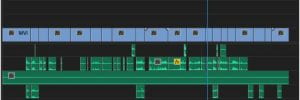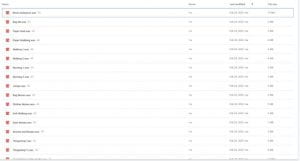Notes
- Saving Private Ryan (1988) dir. By Steven Spielberg, Amblin Entertainment
- Spielberg makes us feel as though we are there, the purpose of filmmaking
- Three Colours: Blue (1993) dir. By Krysztof Kieslowski, MK2 Productions
- White light transitions used to bring them together
- Casablanca (1942) dir. By Michael Curtiz, Warner Bros.
- The essence of Hollywood, full of the yearning and romanticism
- Record of a Tenement Gentleman (1947) dir. By Yasujiro Ozu
- Very restrained and calm cinematography
- Odd Man Out (1947) dir. By Carol Reed, Two Cities
- Protagonist hallucinates problems inside bubbles
- 2 or 3 Things I Know About Her (1967) dir. Jean-Luc Godard
- Same as above, inspiration
- Taxi Driver (1976) dir. Martin Scorsese
- Another inspired by two previous films
- The French Connection (1971) dir. William Friedkin
- Frantic visuals
1895-1918: The World Discovers a New Art Form or Birth of the Cinema
- Traffic Crossing Leeds Bridge (1888) dir. Louis Le Prince
- The Kiss (1896 film) (a.k.a. May Irwin Kiss) (1896) dir. William Heise
- Very relatable
- Workers Leaving the Lumière Factory (1895) dir. Louis Lumière
- A documentary, and the first movie
- Arrival of a Train at La Ciotat (1896) dir. Louis Lumière
- One of the first films shown publicly by the Lumieres
- Annabelle Serpentine Dance (1894-1896 ?) dir. William Kennedy Dickson or William Heise
- Sandow (1894) dir. William Kennedy Dickson
- What Happened on Twenty-third Street, New York City (1901) dir. George S. Fleming and Edwin S. Porter
- Cendrillon (1899) dir. Georges Méliès
- Used cuts to make magic tricks
- Le voyage dans la lune (1902) dir. Georges Méliès
- La lune à un mètre (1898)
- So astonishing the film is given many tributes
- The Kiss in the Tunnel (1899) dir. George Albert Smith
- Used the first “phantom ride” shot
- Shoah (1985) dir. Claude Lanzmann
- Uses phantom rides on the train tracks leading to concentration camps
- 2001: A Space Odyssey (1968) dir. Stanley Kubrick
- Phantom ride of an out of body experience
- The Sick Kitten (1903) dir. George Albert Smith
- Utilized the first close up shot
- October: Ten Days That Shook the World (1928) dir. Sergei Eisenstein
- The close ups of the woman give the scene much more moving
- Once Upon a Time in the West (1968) dir. Sergio Leone
- Only when he looks in close ups does a realization occur
- The Corbett-Fitzsimmons Fight (1897) dir. Enoch J. Rector
- Filmed a boxing match with a broader frame to show more
1903-1918: The Thrill Becomes Story or The Hollywood Dream
- Life of an American Fireman (1903) dir. Edwin S. Porter
- Used editing to make a more cohesive story
- Can now emphasize movement
- Sherlock Jr. (1924) dir. Buster Keaton
- Uses double exposure for magical tricks in the plot
- The Horse that Bolted (1907) dir. Charles Pathé
- Showing parallel editing to show multiple things happening at the same time
- The Assassination of the Duke of Guise (a.k.a. The Assassination of the Duc de Guise) (1908) dir. Charles le Bargy and André Calmettes
- One of the first movies where backs are shown in the frames
- Vivre sa vie (1962) dir. Jean-Luc Godard
- Did not show the actor’s face for the opening scene
- Those Awful Hats (1909) dir. D. W. Griffith
- Using notoriety to make a better connection with audience
- The Mended Lute (1909) dir. D. W. Griffith
- Was supposed to be dead when the movie came out
- The Abyss (1910) dir. Urban Gad
- Less censorship in Europe
- Stage Struck (1925) dir. Allan Dwan
- More focus on extravagance for stars
- The Mysterious X (1914) dir. Benjamin Christensen
- Heavy use of light and contrast in film
- Häxan (1922) dir. Benjamin Christensen
- Complex lighting, a movie about witchcraft
- Ingeborg Holm (1913) dir. Victor Sjöström
- Naturalism and grace
- The Phantom Carriage (1921) dir. Victor Sjöström
- Multiple layers of story
- More double exposure
- Shanghai Express (1932) dir. Josef von Sternberg
- Both bombastic and glamorous while also believable, a place for things to be perfect
- The Story of the Kelly Gang (1906) dir. Charles Tait
- Made in Australia with natural light
- The Squaw Man (1914) dir. Oscar Apfel and Cecil B. DeMille
- Messes up 180 degree rule
- The Empire Strikes Back (1980) dir. Irvin Kershner
- The 180 degree rule makes us believe the characters are facing each other
- Falling Leaves (1912) dir. Alice Guy-Blaché
- Uses poetic storytelling with girl tying leaves back to trees
- Suspense (1913) dir. Phillips Smalley and Lois Weber
- Uses split screens, POV, other ways to show multiple perspectives
- The Wind (1928) dir. Victor Sjöström
- Cinematography shows thoughts of character
- Rescued from an Eagle’s Nest (1908) dir. J. Searle Dawley
- Static painted backdrop cannot show wind
- The House with Closed Shutters (1910) dir. D. W. Griffith
- Way Down East (1920) dir. D. W. Griffith
- Light and visuals match performance
- Natural looking scenes
- Orphans of the Storm (1921) dir. D. W. Griffith
- Messed with lenses and lighting to affect the mood of the films
- The Birth of a Nation (1915) dir. D. W. Griffith
- Shows how film can be used for deception, portrays racist imagery in a good light.
- Rebirth of a Nation (2007) dir. DJ Spooky
- Played with the images
- Cabiria (1914) dir. Giovanni Pastrone
- Moving dolly shots
- Intolerance (1916) dir. D. W. Griffith
- Love through history, the movie takes you through time.
- Souls on the Road (a.k.a. Rojo No Reikan) (1921) dir. Minoru Murata
- The two stories come together over time

